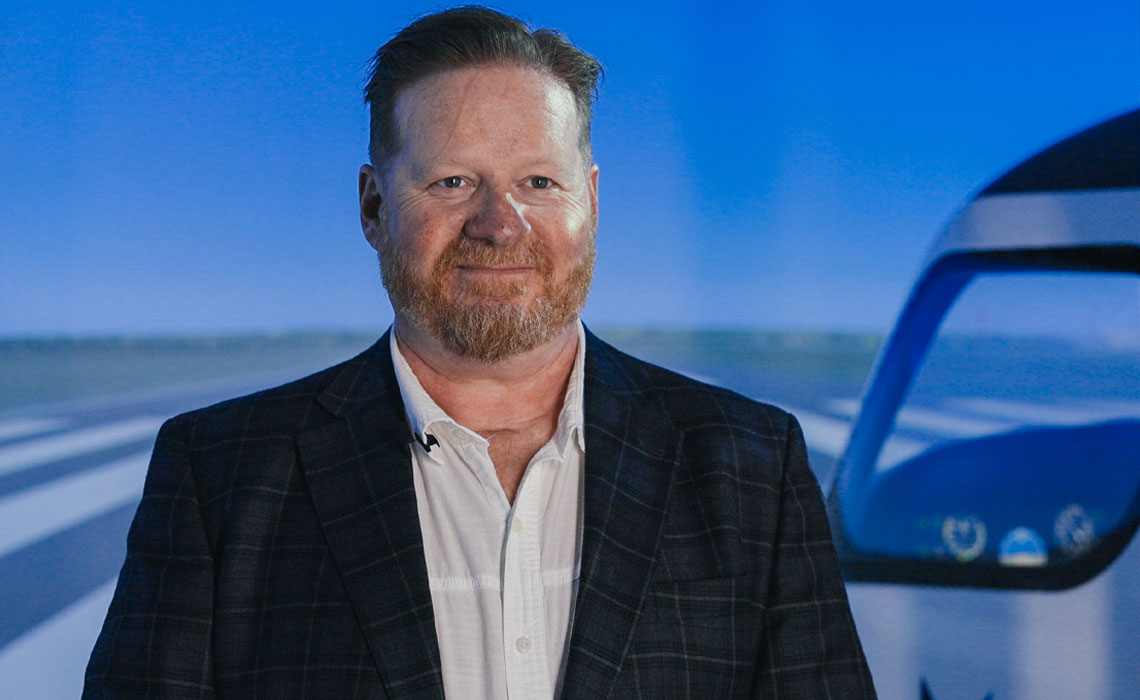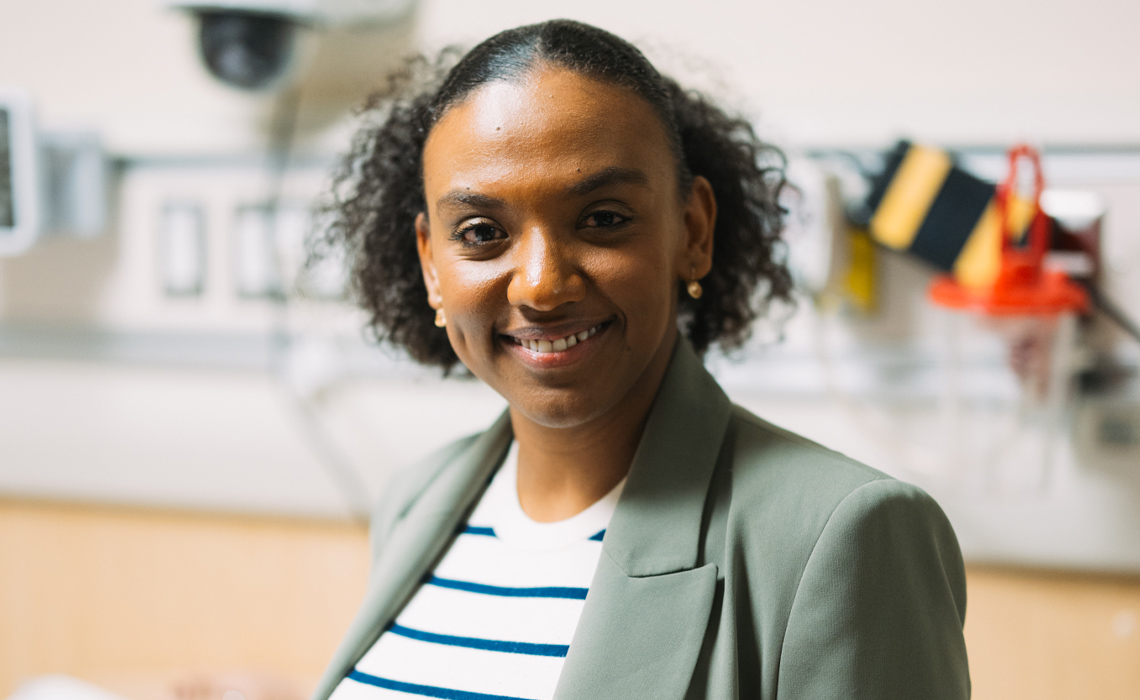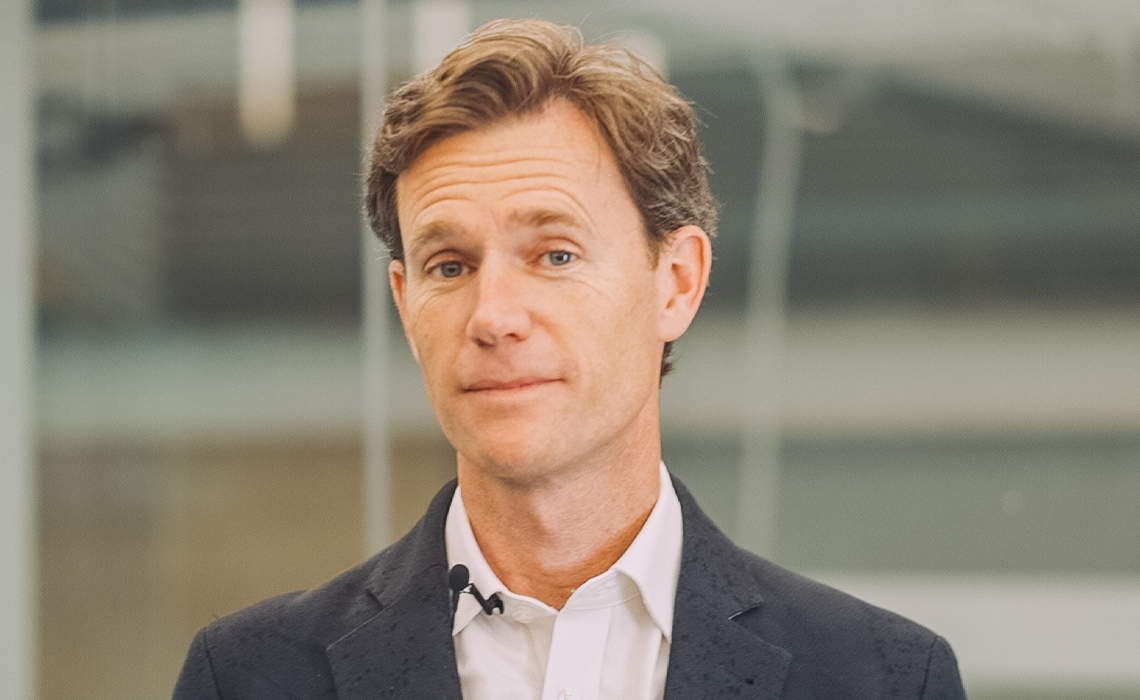Mastering skills safely
MRU hosted its inaugural simulation conference on May 7, 2024. Bridging the Practice Gap with Simulation celebrated and honoured the life of Dr. Paula Price, PhD, past director of the School of Nursing and Midwifery, while gathering together like-minded professionals to promote cross-disciplinary knowledge exchange, innovation and collaboration through immersive live simulation demonstrations.
Experiencing the skies while still on the ground

Mark Benson, an assistant professor with MRU’s acclaimed aviation program, spent six years as the program’s simulator instructor. He says the simulator is an incredible teaching tool that is sometimes better than reality.
Sitting on the “flight deck” of the program’s ALSIM Flight Simulator, MRU aviation students are confronted with tricky and/or treacherous scenarios. Noisy and stressful situations unfolding on a 210-degree, wrap-around projection screen offer students lessons without risk.
“We’ve had people get airsick in that simulator because it’s so realistic,” Benson says. “We can do anything we want very safely.”
Scenarios include navigating a blizzard or a runway obliterated by clouds, or experiencing engine failure or fire.
With the simulator, students can slam on the brakes in the middle of a sketchy situation to correct an error, discuss or debrief, and then recreate it over and over again until skills are mastered.
“You can try things you couldn’t try in the real world,” Benson says. “You can fail safely in a simulator.”
Students practice in everything from a single-engine Cessna to a light-turbojet via simulation. It is far less expensive than taking training to the skies. Simulators are able to cover ground in terms of scenarios in about ten minutes as compared to two to three hours in the sky.
“It’s the absolute versatility. You can go anywhere in the world and be put in any situation and it looks and feels like you are in an airplane moving forward,” Benson says.
“I think education has to be safe and it has to be cost-effective, and that’s where simulation really shines.”
The most patient of patients

Danaiet Teame is manager of MRU’s School of Nursing and Midwifery’s Health Simulation Learning Centre and has long been a fan of simulation learning. The 1,010-square-metre learning centre simulates anything from a full hospital unit to specialized acute care units, and even home-care scenarios, where students can work through clinical problems and put their decision-making to the test.
Teame says it allows for immediate feedback and valuable repetition of skills without the additional stress of treating an actual human.
“We actually want you to make mistakes because the consequences are really a learning opportunity,” Teame says. “So we celebrate mistakes.”
The Health Simulation Learning Centre is a high-tech and meticulously crafted environment that allows students to go beyond theory and prepare for what to expect in work settings. One hour of simulation can equal up to three hours of clinical experience, and when clinical placements are limited, simulation is a great option.
“When we are talking about simulation and debriefing, we are looking for a teaching strategy that mimics realism,” Teame says. “There’s so much you need to learn as a health-care provider. Beyond the content, I want to teach you how you respond to certain things by exposing you to different levels of scenarios.
“You may be anxious, nervous, scared, and that is okay. It's not only about dealing with the task at hand, but it's also about dealing with you. It’s kind of like reverse teaching — how do you respond in these moments? And how we can support you by reminding you of the resources, knowledge and skills you have within you. Each simulation begins with our basic assumptions, adapted from the Harvard assumptions, which state, ‘We believe that everyone participating in activities at the MRU SIM Lab is intelligent, capable and cares about doing their best and wants to improve.”
MRU nursing and midwifery students can practice placing IVs in arms and inserting catheters or chest tubes on task trainers. Debriefing and discussion with instructors furthers learning experiences and builds confidence.
And then there is Victoria. She’s given birth many times. It’s often complicated and challenging but she’s always in good hands and ready to do it again. And again.
The birthing mannequin, which can be programmed to dovetail into curricula, exposes students to everything from breech births to postpartum hemorrhages. She can even suffer a seizure during labour.
A standardized patient program employs professional actors and actresses to take the realism up another notch by bringing scripted scenarios to life.
“Students suspend their disbelief and the buy-in is real,” Teame says.
A healthy portion of simulation in education appeals to a new generation of students who no longer learn by rote but enjoy active learning. While simulation learning began with aviation, it’s now a bonafide part of schooling in disciplines including medicine, nursing, social work, midwifery and athletic-therapy programs.
Conservatory simulation learning soon to take the stage

It didn’t matter how much he mastered a piece in practice, when it was time for the director of Mount Royal’s Conservatory, Terry Clark, PhD, to play before a live audience, his body seemed to betray him.
“You feel your heart rate go up and your stomach muscles start to tighten,” Clark says. “My lower lip would start to shake.”
Not ideal for a flute player. Over time, Clark learned it was simply his “body getting ready for performance” and learning to cope. It meant becoming familiar with the signs and eventually reframing his thinking.
Clark is a world-class performer with years of experience. Imagine the performance anxiety and trepidation for students across the spectrum of disciplines as they shift from relative safety of their classrooms to the real world.
That’s exactly why simulation is so important at Mount Royal.
Clark says about 98 per cent of a musician’s time is spent in a practice room with little resemblance to the performance halls where they often end up.
“In a concert hall people sneeze and cough, their phones go off,” he says. “In a practice room there are virtually no distractions so it’s very easy to maintain focus. You are not dealing with someone else’s expectations, but in a concert hall it can become very easy to fixate on the audience and what they think.”
Prior to joining MRU, Clark managed performance simulators at the Royal College of Music in London, England. Its simulation suite relies on mixed reality to recreate the sights and sounds associated with performing in a concert hall. Students start in a green room, then move to backstage where they interact with the manager before the doors open and they walk out in front of an audience comprised of avatars.
“Instructors can manipulate an audience to be noisy or quiet or heckle or look really engaged,” Clark says. “We can expose musicians to the kind of things they can get in a live environment.”
He says the Conservatory will introduce similar simulation in the near future. For now, they build in opportunities to help students transition their talents beyond MRU, which includes performing in the community or bringing in fellow students as an audience.
“Fundamentally, it’s about exposing students to real-world performance conditions and helping them to learn to become familiar within those,” he says. “The beauty of simulation is you can gain real-world experience, but in the safety of practice of environment.”
Find out more about innovation in teaching and learning at Mount Royal.

